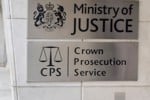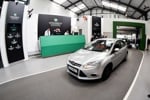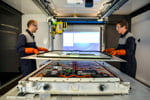Jaguar Land Rover (JLR) has announced a major £500 million investment to transform its historic Halewood plant into a state-of-the-art facility capable of producing electric vehicles (EVs) alongside traditional combustion and hybrid models.
Originally built in 1963 to manufacture the Ford Anglia, the site is being reimagined to support JLR's electrification goals.
With £250m already invested, the transformation has included over a million hours of construction work over the past year. The facility has expanded by 32,364 sqm, allowing it to produce JLR's medium-sized luxury electric SUVs on the new Electric Modular Architecture (EMA) platform.
 Halewood has been outfitted with cutting-edge technology, including new EV production lines, 750 autonomous robots, laser alignment systems, Advanced Driver Assistance System (ADAS) calibration rigs, and cloud-based digital plant management systems - turning it into a "factory of the future."
Halewood has been outfitted with cutting-edge technology, including new EV production lines, 750 autonomous robots, laser alignment systems, Advanced Driver Assistance System (ADAS) calibration rigs, and cloud-based digital plant management systems - turning it into a "factory of the future."
This substantial investment aligns with JLR's "Reimagine" strategy, which aims to electrify its entire lineup by 2030 and achieve carbon net-zero status across its supply chain, products, and operations by 2039.
Halewood will initially produce internal combustion engine (ICE), plug-in hybrid electric vehicle (PHEV), and battery electric vehicle (BEV) models simultaneously before eventually becoming JLR’s first all-electric production facility.
Barbara Bergmeier, JLR's executive director of industrial operations, said: "Halewood has been the heart and soul of JLR in the north west of England for well over two decades. It will be our first all-electric production facility, a testament to the brilliant efforts of our teams and suppliers."
Key developments at Halewood will feature a new body shop capable of producing 500 vehicle bodies per day, an expanded paint shop with 1.4 km of modified space, an extended final production line to accommodate battery installation with 40 new Autonomous Mobile Robots (AMRs).
High Voltage Training (HVT) will be provided to over 1,600 employees and £16m worth of reusable equipment will be integrated from JLR's Castle Bromwich site.
The site will soon benefit from 18,000 photovoltaic panels, generating 8,600 GWh of energy -about 10% of the plant’s energy needs. Additionally, JLR aims to cut 40,000 tonnes of CO2 emissions from the site’s industrial footprint through renewables, fuel switching, and energy efficiency improvements.
















Login to comment
Comments
No comments have been made yet.